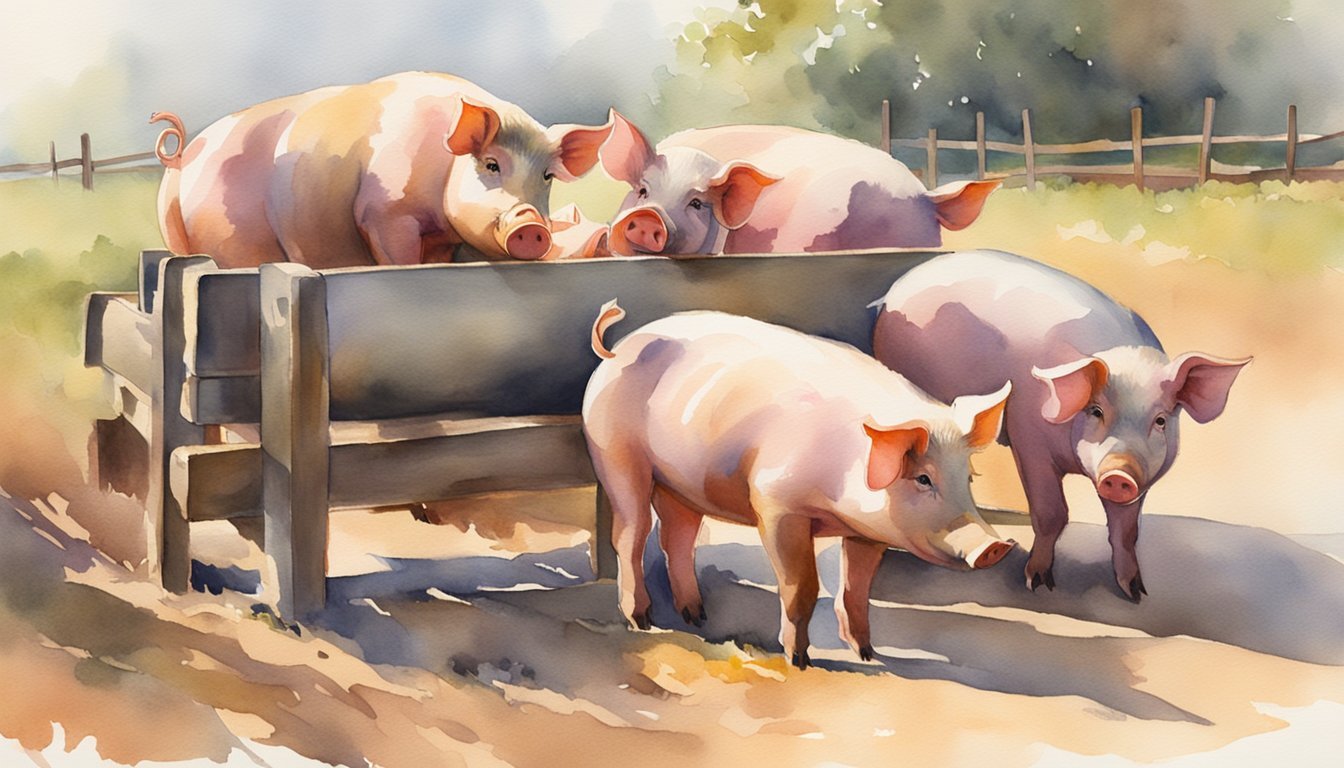Understanding Pigs
Pigs are a fascinating and diverse group within the animal kingdom, known for their distinctive physical features and complex behaviors. They are versatile animals that appear in a variety of breeds both domestic and wild.
Physical Characteristics
Pigs, members of the Suidae family, exhibit a range of physical traits. Adult pigs typically vary in size and weight, with domestic swine often exceeding 50 to 350 kilograms, while wild boars, the wild relatives of the domestic pig, may weigh over 150 kilograms. Pigs are recognizable by their stout bodies, short legs, and a prominent snout used for their keen sense of smell. Despite common misconceptions, pigs have minimal sweat glands and cannot sweat well, leading them to wallow in mud to regulate their body temperature. Moreover, varieties of the Eurasian boar possess coarse hair and elongated tusks.
Behavior and Habitat
Pigs are omnivorous mammals, thriving on a diet composed of both plant and animal materials. This adaptive feeding behavior makes them successful foragers, often seen digging or rooting around with their snouts to find food. Pigs from the Sus genus, including both domestic and feral variants, are incredibly social and intelligent animals. Wild pigs, or swine, typically inhabit forests and grasslands, exhibiting a behavior known as wallowing to cool down and protect their skin from parasites. Feral pigs, on the other hand, are domestic pigs that have adapted to live in the wild.
Social Structure and Reproduction
Within their social groups, pigs develop complex hierarchies. Domestic pigs tend to live in herds, managed by farmers, who rely on understanding pig behavior for effective husbandry. These herds often consist of females and their young, with boars typically being more solitary. Pigs are communicative creatures, with vocalizations that indicate a rich emotional state. The reproductive cycle of pigs includes a gestation period of around 114 days, after which sows give birth to a litter of piglets. These piglets are weaned at different stages depending on whether they are wild or domestic.

Discover more about the Physical Characteristics of pigs at Understanding Your Herd. For fascinating insights into pig behavior, visit Pig Behavior – Animal Health and Welfare Knowledge Hub. Learn more about their Social Structures and Reproduction at PDF About Pigs.
Pigs in Culture and Industry
Pigs have had a profound influence on human civilizations, serving not only as a vital source of sustenance but also featuring prominently in various cultural narratives and industries.
Economic and Culinary Significance
Pigs hold significant economic value across the globe, with China leading as the largest producer and consumer of pork. The presence of pigs in various economies is not merely limited to the production of meat; industries also gain from by-products such as leather and bristles. Culinary traditions surrounding pork vary widely, from European charcuterie to traditional American barbecue.
The pig farming sector continually evolves, with shifts towards animal welfare-centric farming and discussions aimed at improving the appeal of pig farming for future generations, indicating a complex relationship between livestock and market demands.
Pigs in Media and Entertainment
Pigs often take center stage in media and entertainment. For instance, Nicolas Cage starred as a truffle hunter in the drama-thriller film “Pig,” directed by Michael Sarnoski. This narrative explores themes of love and loss with a backdrop of culinary arts, illustrating how pigs are woven into the tapestry of storytelling. The film’s release into theaters underlines pigs’ cultural resonance beyond mere livestock, highlighting broader human experiences and emotions.
Conservation and Ethical Considerations
The domestication of pigs has long-standing implications for both conservation and ethics in modern society. As the demand for pork continues to grow, so does the conversation around humanity’s ethical responsibilities towards these animals. Wild boars, the ancestral counterparts of domestic pigs, face differing conservation issues, often being subject to hunting controls due to their impact on ecosystems and agricultural regions.
Advocates for pig welfare have prompted the swine industry to re-evaluate practices, aiming for a future where the culture of pig farming is sensitive to both environmental and ethical considerations, reflecting humanity’s evolving values.

